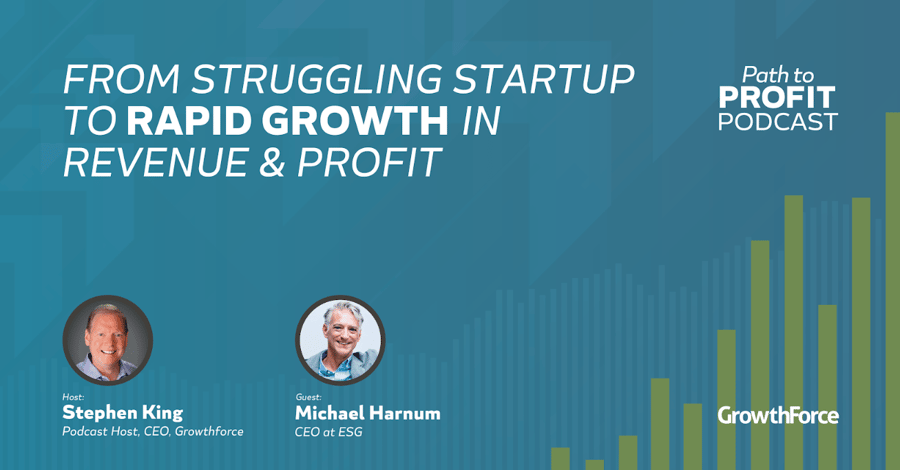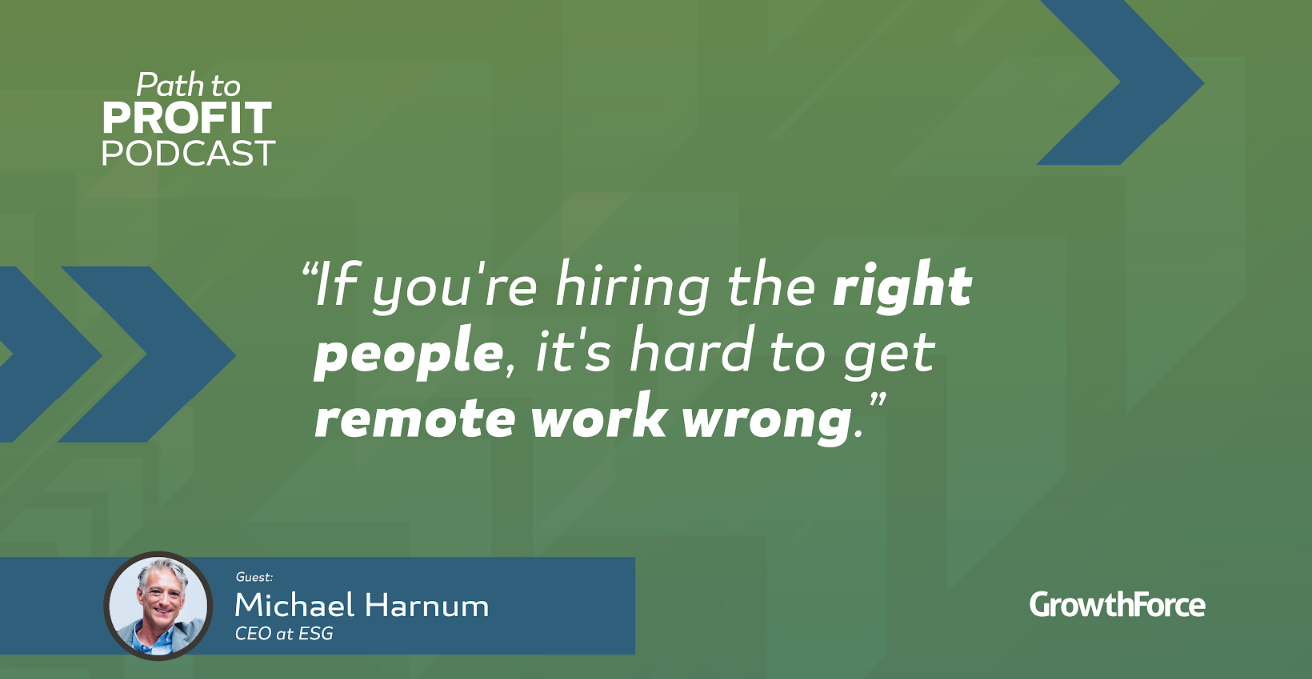8 min read

How do you measure growth in your business? Are you focusing on your top line or the bottom line growth?
|
Key Takeaways
|
Five years ago, ESG, a SaaS company that provides customer success as a service, was stable and profitable.
However, when Michael Harnum joined the then 16-year-old company as CEO, his first order of business was to find out why it was not growing. Here we are, five years since Harnum joined ESG, and the company has grown from a struggling startup to a high-growth company with $10 million in top-line revenue, $3 million in bottom-line profits, and over 70 employees.
In a recent episode of Path to Profit, Harnum sat down with GrowthForce Founder and CEO, Stephen King to share how he turned ESG into the growth machine that it is today, boiling down his process into four basic steps that any stagnant company can apply to jump-start their own business model while learning to balance their growth on both the top and bottom lines.
🎧 Prefer sound bites over blogs? Listen to the full episode here!
4 Steps to Translating Top Line Expansion to Bottom Line Growth
1. Identify Markets With Growth Potential
When Harnum joined ESG, the company had a very small, highly specific, niche market; they solely served the training and education departments of technology companies. While niches can be very profitable markets to serve because they offer built-in differentiation that sets a business apart from the rest, they can also be limited if they are small and specific enough. Harnum identified the size and scope of the company's market as one of ESG's key barriers to growth. They had a market, but it was limited in terms of potential and in terms of their average client's budget size. While Harnum recognized that they were serving their market well, he realized they needed to swim in a bigger pool.
"I want markets in addition to that. How can we expand our service portfolio out into other markets, so that we can get into markets that are growing, get into markets that have bigger budgets, get into markets that have progressive thinkers in decision making roles?"
After realizing that ESG needed a bigger, more diverse market and asking himself these key questions, he realized that the software subscription market was expanding fast and could benefit from the services of ESG. He had effectively identified a new constituency that could directly benefit from the services of ESG. Better yet, the software subscription market was growing fast which meant their new market would have the power to fuel limitless sales possibilities.
"So, that's the first thing," said Harnum, "is make sure that your company is in the right market, and that the market will put wind in your sails and that needs to be true for you."
2. Standardize and Optimize Project Scope and Pricing
In his business, Harnum refers to this step as deal sheet discipline which has been made possible by standardizing their fees and project scope on a deal sheet that outlines their basic costs of different services and levels of services they provide. Their basic deal sheet structure allows his sales representatives to take on the clients whose needs ESG can solve and to walk away from those they can't. Ultimately, it allows them quickly identify which sales are actually going to be profitable and which simply won't work.
Pricing in service businesses can be challenging to say the least. Direct labor is by far your biggest direct cost, but without the right time-tracking tools in use, it can be next to impossible to determine how much labor each of your employees actually dedicates to individual clients or jobs. Depending on the type of work you do, each job or client might be wildly different which can also make it difficult to sort your clients and jobs into standardized type-based categories.
Read More: Don't Be a Pricing Coward! Get This Under Control…
It's essential, however, that you find a way to do both of these things in a service business. You must identify and define the project scope for each standard type of service you provide and/or each standard type of client you serve. Then, you need to determine your true costs in providing those services or serving those clients so that you can optimize your pricing to ensure profits on the sales you make and avoid losses on the deals you choose to pass over.
3. Start Thinking Upstream
The next step is to identify the leading indicators that lead to your desired lagging indicators so that you can quickly identify real opportunities for profits before you actually see the profits.
As Harmon put it, "You [have] really got to move your thinking upstream in terms of leading versus lagging indicators in the marketplace that will tell you a lot about the opportunities you're pursuing and whether they even have a chance to be profitable." He explained further, "To us, lagging indicators are revenue and profit. That's the end of the sentence . . . that's where you want to wind up, but what do [you] need to know further upstream that will get me to the answer that I like for revenue and profit."
Read More: Successful CEOs Never Stop Learning
For example, leading indicators are like candy wrappers that tell you what's inside. If you want to eat chocolate (your lagging indicator), then you look for a wrapper (leading indicator) that says "chocolate."
In ESG, Harmon's strongest leading indicators are the company's ability to solve a client's or entire marketplace's problems. He said, "If you're well-positioned to solve the problems in the industry, that's an important leading indicator to understand because, ultimately, that will lead to answers that you're happy with in terms of revenue and profit."
4. Hire the Right People for Remote Work
During the pandemic, Harmon shifted ESG from a business model that was based in and working out of two offices to a remote workplace model with employees scattered all across the country. To do this successfully, Harmon said ESG focused on a couple of issues right away.
First, they refined their hiring process. Harmon explained that they began introducing themes related to remote work into their interviewing process. To identify people who could handle remote work roles and manage themselves well, for example, they started providing interviewers with the following sorts of prompts, questions, and discussion topics:
- Tell us how you manage yourself.
- How do you hold yourself responsible?
- Give us an example of a scenario where perhaps you tasted independence for the first time and what you did with it and how you reacted to that.
- What do your daily schedule and routine look like?
- What does personal discipline mean to you?
Secondly, they expanded their hiring process. "We took advantage of this as an opportunity to talk to and identify talent in states we had not previously hired," Harmon said, "because we knew we were going to have to hire folks remotely anyways."
Read More: Maximize Your Business Profit With High-Performing Teams
When Harmon started with ESG five years ago, they were located in one state. Now, they're in 14. As a high-level, white-glove service business, they are also a talent business which means that expanding their footprint through the remote workplace also allowed them to expand their hiring pool and access the top talent in their industry.
Once you have your remote work technology in place and all the IT bugs worked out, Harmon followed up with this advice, "If remote work is not working for you, I would circle you back to your hiring process. My theory is if you're hiring the right people, it's hard to get this wrong."

Harmon has adjusted his hiring process, interview questions, and culture-building activities to increase remote productivity by ensuring he hires the right people. However, this is a rule to live by regardless of whether you have a hybrid, remote, and 100% on-location office model. Hiring the right people is essential to maximizing productivity, fostering a positive workplace culture, and – perhaps most importantly – reducing costly employee turnover.
Don't Eat Your Own Profits: Focus on CEO Productivity Too
As CEO, a big mistake you can make that can eat away at your revenue growth so that it never touches your bottom line is wasting your own time. As the likely top-paid employee at your company, it's essential that you be extremely mindful of how you spend every minute of your time. Losing time to too many distractions (emails, phone notifications, or knocks on your door) throughout the day or spending your time completing low-value tasks that could easily be delegated to someone else are all activities that will steadily chip away at your company's profits.
To ensure you're maximizing ROI on your own time, take a page out of Harnum's CEO playbook. He focused on birds-eye-view strategic planning by identifying markets with greater potential, determining his company's most-successful leading indicators, reworking operation and pricing strategies, and successfully pivoting to a remote work environment.
To get the most out of their time, maximize ROI, and accelerate business growth, all CEOs should likewise carefully schedule their time each day by implementing smart strategies for successful time management, in addition to dedicating themselves to focusing solely on high-value jobs, business leadership, and business strategy while on the clock.



